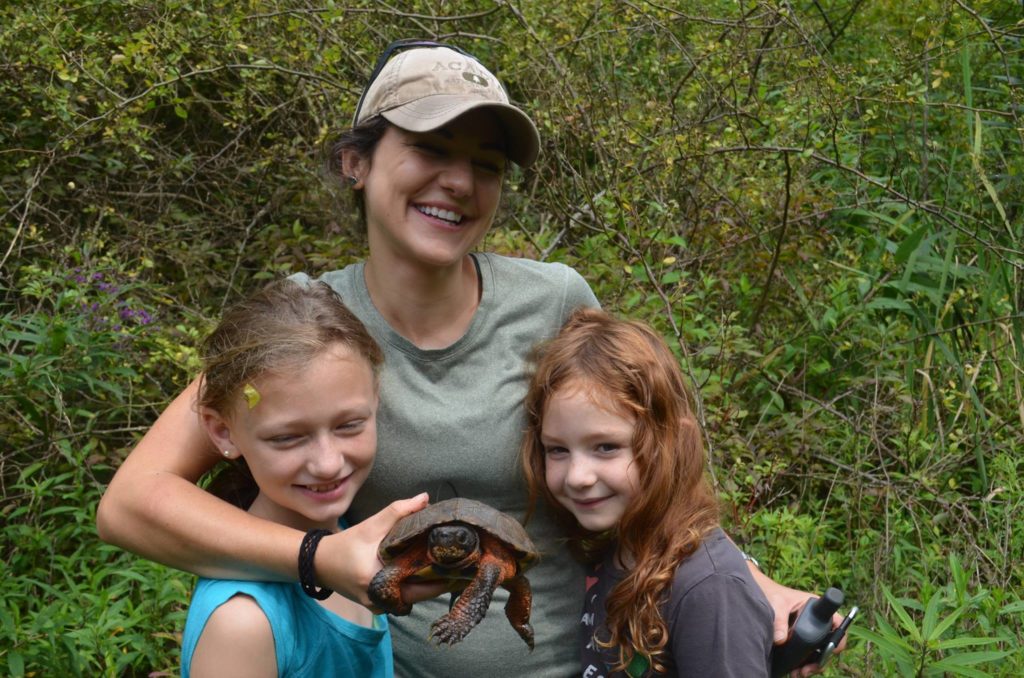
Nestled in Penn State’s 7,000-acre Stone Valley Experimental Forest, Shaver’s Creek is not only a place for children and families to discover the natural world, but a field laboratory for Penn State students and faculty to carry out research in the areas of environmental education; plant sciences; recreation, park, and tourism management; and more!
Family Learning in the Outdoors
With family groups as one of the most common social groups to visit informal learning sites (like Shaver’s Creek), this research initiative aims to better understand how families interact with outdoor spaces and with each other to learn about science and nature. A second goal of this research initiative is to explore how families’ outdoor learning experiences can be facilitated through public programs, science tools, and inquiry activities.
Research lead: Lucy McClain
Integrating Mobile Technologies into Outdoor-Based, Informal Learning Spaces
Given the ubiquity of mobile technologies in the 21st century, it is important to investigate how mobile-based educational programs can be consciously designed to support, rather than detract from, the learning experience, particularly when learning is situated in the outdoors. Consequently, this research initiative explores what it means to be ‘engaged’ with nature when mobile devices are facilitating the educational experience and what mobile-based design features contribute to one’s interactions with the environment.
Research lead: Lucy McClain
Plant Science

The Appalachian Botany and Ethnobotany Program at Shaver’s Creek, under the leadership of Program Director Dr. Eric Burkhart, often working with partners such as the Pennsylvania Department of Conservation and Natural Resources, includes research on native plants of economic and conservation importance, such as American ginseng and goldenseal.
Research Lead: Eric Burkhart
Wood Turtles

The Wood Turtle (Glyptemys insculpta), like over half of all turtle and tortoise species worldwide, is threatened with extinction. Listed by the International Union for the Conservation of Nature (IUCN) as endangered, wood turtle populations throughout their range have been quietly but persistently diminishing. Reliant on a mosaic of habitat types, this semi-aquatic turtle will spend a potentially long lifespan tethered to a perennial stream or riverine system. Healthy lotic waterways are essential for hibernation during winter, while surrounding terrestrial habitat provide areas for foraging and nesting. A key component to wildlife management and effective recovery strategies for at-risk species is to monitor site-level status of populations. Population monitoring can reveal changes in distribution, abundance, and population structure, as well as helping to advance our understanding of habitat use over time. Accurate estimates of population abundance and density are especially critical for species of conservation concern. The objective of our research is to provide baseline information on demography, morphometrics, and home-range size, and to evaluate habitat use within the Shaver’s Creek basin.
Visual encounter surveys and capture-mark-recapture methods have been employed to gather data on population abundance, sex ratios, and body size of individuals. Movement and habitat-use patterns were determined through radio telemetry tracking, which coupled with ArcMap data can be used to ascertain home ranges, telling us how much space an individual needs and what type of habitat they prefer. Utilizing recent advances in sequence-based monitoring tools, we will evaluate the use of environmental DNA (eDNA) to determine how detection probability is influenced by seasonal activity patterns of wood turtles. The Shaver’s Creek wood turtle population has provided an excellent natural classroom for offering students hands-on experience with wildlife management and enhancing awareness of the need for conservation of the species. Wood turtle surveys have been incorporated into Wildlife and Fisheries classes for Penn State undergraduate students, and children participated in radio telemetry tracking of turtles during Shaver’s Creek’s Nature Camps.
Scattered remnants of once thriving populations have become disjunct and isolated as habitat fragmentation continues to fracture the landscape. Connectivity is key not only for turtles to carry out their annual activity patterns, but for genetic diversity to be maintained across populations. Taken together, lack of suitable nesting habitat, low hatchling survival, and increasing adult mortality result in little to no recruitment. In other words, no young turtles to replace aging members of the population. These trends are leaving behind so called “ghost” populations, which will persist only as long as their longest-living individuals. Conserving wood turtle populations will require sweeping action across the entire range of the species. Understanding aspects of current population dynamics, habitat selection, and activity patterns, and the use of monitoring tools are essential for developing effective management and conservation strategies.
Research Lead: Carli Dinsmore
Graduate Student Opportunities
The Shaver’s Creek Field Laboratory offers a number of Penn State graduate assistant (GA) positions, ranging in focus from adventure education to environmental interpretation. For instance, past graduate students have studied our Outdoor School and family programs to gauge the effectiveness of environmental education at changing children’s attitudes about the natural world.
Penn State students and faculty interested in carrying out research in any of these areas and/or using Shaver’s Creek as a field site for your program should contact us for more information.


